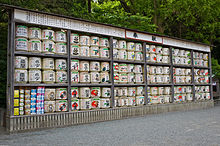
Back ساكي Arabic ساكى ARZ Sake AST Sake Azerbaijani Saké BAN Sakė BAT-SMG Sake BCL Сакэ Byelorussian Сакэ BE-X-OLD Саке Bulgarian
 Sake can be served in a wide variety of cups. Pictured is a sakazuki (a flat, saucer-like cup), an ochoko (a small, cylindrical cup), and a masu (a wooden, box-like cup). | |
| Type | Alcoholic beverage |
|---|---|
| Country of origin | Japan |
| Alcohol by volume | 15–22% |
| Ingredients | Rice, water, kōji-kin (Aspergillus oryzae or Aspergillus kawachii or Aspergillus luchuensis[1][a]), yeast |


Sake, saké (酒, sake, /ˈsɑːki, ˈsækeɪ/ SAH-kee, SAK-ay[4][5]), or saki,[6] also referred to as Japanese rice wine,[7] is an alcoholic beverage of Japanese origin made by fermenting rice that has been polished to remove the bran. Despite the name Japanese rice wine, sake, and indeed any East Asian rice wine (such as huangjiu and cheongju), is produced by a brewing process more akin to that of beer, where starch is converted into sugars that ferment into alcohol, whereas in wine, alcohol is produced by fermenting sugar that is naturally present in fruit, typically grapes.
The brewing process for sake differs from the process for beer, where the conversion from starch to sugar and then from sugar to alcohol occurs in two distinct steps. Like other rice wines, when sake is brewed, these conversions occur simultaneously. The alcohol content differs between sake, wine, and beer; while most beer contains 3–9% ABV, wine generally contains 9–16% ABV,[8] and undiluted sake contains 18–20% ABV (although this is often lowered to about 15% by diluting with water before bottling).
In Japanese, the character sake (kanji: 酒, Japanese pronunciation: [sake]) can refer to any alcoholic drink, while the beverage called sake in English is usually termed nihonshu (日本酒; meaning 'Japanese alcoholic drink'). Under Japanese liquor laws, sake is labeled with the word seishu (清酒; 'refined alcohol'), a synonym not commonly used in conversation.
In Japan, where it is the national beverage, sake is often served with special ceremony, where it is gently warmed in a small earthenware or porcelain bottle and sipped from a small porcelain cup called a sakazuki. As with wine, the recommended serving temperature of sake varies greatly by type.
Sake now enjoys an international reputation. Of the more than 800 junmai ginjō-shu evaluated by Robert Parker's team, 78 received a score of 90 or more (eRobertParker, 2016).[9]
- ^ Cite error: The named reference
kawachii220520was invoked but never defined (see the help page). - ^ Cite error: The named reference
matsushima210122was invoked but never defined (see the help page). - ^ 麹のこと Marukome co., ltd.
- ^ The American Heritage Dictionary of the English Language. Boston: Houghton Mifflin Harcourt. 2011. p. 1546. ISBN 978-0-547-04101-8.
- ^ The Oxford Dictionary of Foreign Words and Phrases. Oxford: Oxford University Press. 1997. p. 375. ISBN 0-19-860236-7.
- ^ "Definition of SAKE". www.merriam-webster.com. Retrieved June 4, 2024.
- ^ "alcohol consumption". Encyclopedia Britannica. Retrieved March 9, 2017.
- ^ Robinson, Jancis (2006). The Oxford Companion to Wine (3rd ed.). Oxford University Press. p. 10. ISBN 978-0-19-860990-2.
- ^ Sato, Jun; Kohsaka, Ryo (June 2017). "Japanese sake and evolution of technology: A comparative view with wine and its implications for regional branding and tourism". Journal of Ethnic Foods. 4 (2): 88–93. doi:10.1016/j.jef.2017.05.005.
Cite error: There are <ref group=lower-alpha> tags or {{efn}} templates on this page, but the references will not show without a {{reflist|group=lower-alpha}} template or {{notelist}} template (see the help page).